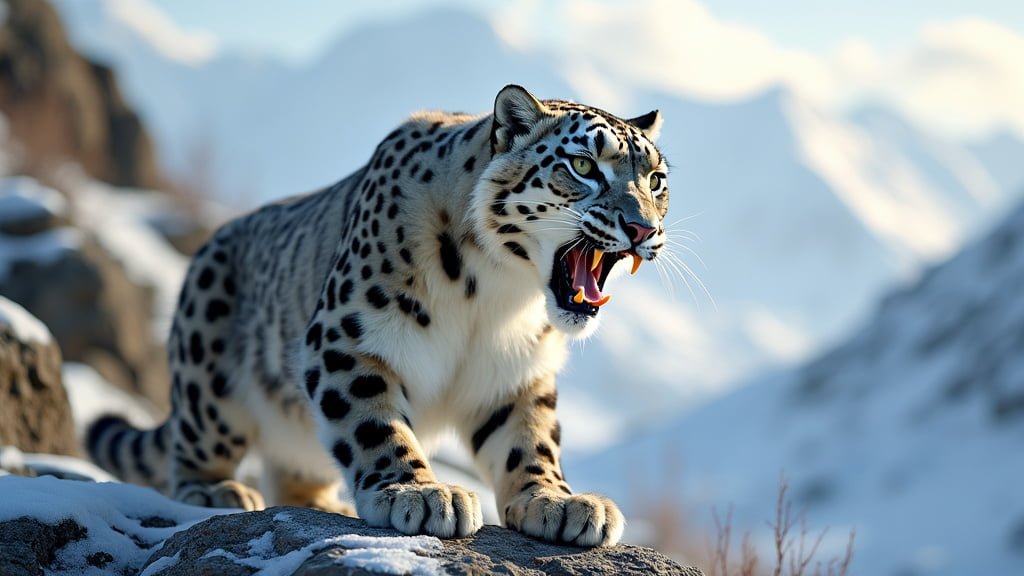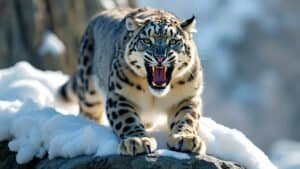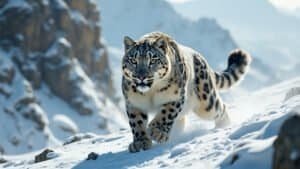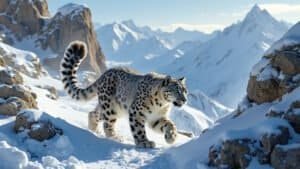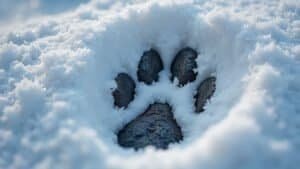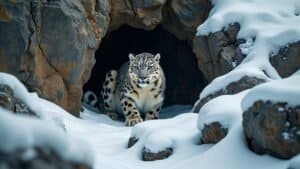Introduction
Snow leopards, elusive and majestic creatures of the high mountains, communicate with each other in fascinating ways. Vocalizations play a crucial role in their interactions, from establishing territory to bonding with their young
This article will explore the types of sounds snow leopards make, their purposes, and how these vocalizations vary depending on the situation. We will delve into how these vocal signals are used during mating season and in mother-cub interactions, offering insights into the complex communication system of these remarkable felines
Types of Snow Leopard Vocalizations
Snow leopards, though elusive and solitary, are known for their varied and complex vocalizations, which they use to communicate in their rugged, mountainous habitats
Unlike the roaring of lions or the purring of domestic cats, snow leopards have their own unique range of sounds that serve specific purposes, from marking territory to mating calls. Understanding these vocalizations provides insight into their behavior and social interactions in the wild
Common Sounds Snow Leopards Make
Snow leopards produce a variety of sounds, each with distinct meanings and functions. The most recognizable of these is the “roar,” although it’s not as powerful as the roar of larger cats like lions
This sound, often described as a “sawing” noise, is typically used by snow leopards to communicate over long distances, particularly in the expansive mountain ranges they inhabit. The roaring sound is produced by a combination of vocal fold vibrations and the shape of the snow leopard’s larynx, which differs from other big cats, leading to a softer, less aggressive tone
Another common sound is “chuffing,” a non-threatening vocalization used in friendly interactions. Chuffing, also known as “prusten,” is a series of short, repeated exhalations through the nose and mouth
This sound is often heard between snow leopards during close encounters, particularly in social contexts or between a mother and her cubs. Unlike the roar, chuffing is a softer, less intense sound, indicating a non-aggressive intention, often used to greet or reassure
Snow leopards also produce hisses, growls, and mews. Hissing and growling are typically defensive sounds, used when a snow leopard feels threatened or during confrontations with other animals or snow leopards
Mewing, on the other hand, is a high-pitched sound often associated with cubs, but adults may use it as well, especially in situations of distress or to signal a need for attention
Vocalization Variations by Situation
The context in which a snow leopard vocalizes greatly influences the type of sound it produces. For example, a snow leopard defending its territory will typically use low growls or more assertive roars to warn intruders
In contrast, a snow leopard interacting with its mate or offspring might use chuffing or gentle mews to convey a peaceful intent
During the mating season, vocalizations become more pronounced and varied. Males are particularly vocal during this period, using a combination of roars and chuffing to attract females and assert dominance over other competing males. Females may respond with a series of soft calls, indicating their receptiveness and encouraging the male to approach
Environmental factors also play a role in vocalization variations. The rugged terrain and altitude of the snow leopard’s habitat affect how far and clearly their vocalizations can travel
For instance, a snow leopard might roar more frequently in areas with large open spaces where sound can carry farther, while in densely vegetated or rocky areas, where sound may be obstructed, it might rely more on close-range vocalizations like chuffing or hissing
Unique Vocalizations and Their Purposes
One of the most unique vocalizations of snow leopards is the aforementioned “chuffing.” While other big cats like tigers also chuff, snow leopards have adapted this sound to suit their solitary and high-altitude lifestyle. Chuffing serves multiple purposes: it is used in mating rituals, to soothe cubs, and as a non-threatening greeting between individuals
The adaptability of this vocalization underscores the snow leopard’s need to balance communication with the necessity of avoiding detection by potential threats or rivals in its harsh environment
Another distinctive vocalization is the “yowl,” which is a long, drawn-out call used during the mating season. This call can be heard over long distances, allowing a snow leopard to attract a mate even across the vast, sparsely populated ranges they inhabit
The yowl is particularly important in the early stages of the mating season when females are seeking to advertise their readiness and attract potential partners
Additionally, snow leopards utilize vocalizations to maintain contact between mothers and cubs. Cubs, which are born blind and helpless, rely heavily on their mother’s vocal cues to understand their environment and feel secure
The mother uses soft, rhythmic calls to guide her cubs, especially when moving through dangerous terrain. These sounds help the cubs stay close and avoid getting lost or exposed to predators
Overall, snow leopards’ vocalizations are a critical component of their survival strategy, enabling them to communicate effectively despite the challenges of their remote, rugged habitats. These sounds not only facilitate social interactions but also play a crucial role in reproduction, territory maintenance, and the rearing of young
The Role of Vocalizations in Territorial Behavior
Vocalizations play a vital role in how snow leopards establish and maintain their territories. These elusive cats, often solitary in nature, use sound as a primary means of communicating their presence to other snow leopards across the vast and rugged landscapes they inhabit
Understanding the intricacies of these vocal signals provides insight into the territorial dynamics and social structure of snow leopards
How Snow Leopards Establish Territory
Snow leopards are highly territorial animals, with individuals occupying vast home ranges that can span several square miles, depending on the availability of prey and the terrain
Vocalizations are a key method for marking these territories, particularly in areas where visual markers like scent markings might be less effective due to harsh environmental conditions
A snow leopard’s roar is one of the primary vocal tools used to establish its territory. This sound, often heard echoing through mountain valleys, serves as a powerful signal to other snow leopards that the area is occupied
Roaring helps to minimize physical confrontations by clearly delineating boundaries; other snow leopards are more likely to avoid areas where they hear these vocal signals, thus reducing the likelihood of territorial disputes
Additionally, snow leopards use a combination of vocalizations and physical markings, such as scraping the ground or leaving scent marks, to reinforce their territorial claims
The roar acts as an auditory boundary marker, while physical signs provide a tangible confirmation of the leopard’s presence. This combination of vocal and physical communication ensures that other snow leopards receive a clear and consistent message regarding territory ownership
Vocal Signals for Territory Defense
In defending their territories, snow leopards rely heavily on vocalizations to deter intruders. When another snow leopard encroaches on its territory, the resident snow leopard may escalate from subtle vocalizations like growls to more intense sounds, such as roars or hisses, depending on the perceived threat level
A growl, which is a deep, rumbling sound, often serves as a warning signal. It indicates the resident snow leopard’s willingness to defend its territory, potentially deterring the intruder from advancing further
If the intruder persists, the vocalizations can escalate to roars, which are more aggressive and indicate that the resident is prepared to defend its territory through confrontation if necessary
Interestingly, snow leopards are known to adjust the frequency and intensity of their vocalizations based on the intruder’s response. For example, if the intruder retreats after hearing a growl, the resident may not escalate to a roar
However, if the intruder shows signs of challenging the resident’s claim, the vocalizations will become louder and more frequent, signaling that the resident snow leopard is ready to defend its territory aggressively
These vocal exchanges can sometimes resolve conflicts without the need for physical confrontation, which can be dangerous and energy-draining for both parties
By effectively communicating through vocalizations, snow leopards can maintain their territories and avoid unnecessary fights, conserving their energy for hunting and other essential activities
Differences in Vocalizations Among Males and Females
There are notable differences in how male and female snow leopards use vocalizations for territorial purposes. Males typically have larger territories than females, often overlapping with the territories of several females
As a result, male snow leopards are more vocal, especially during the mating season, when they need to assert dominance over other males and attract females
Male snow leopards use deeper, more resonant roars to establish and defend their territories. These vocalizations serve to communicate both their physical presence and their readiness to confront any potential rivals
The depth and intensity of a male’s roar can also indicate its size and strength, deterring smaller or weaker males from challenging them
Female snow leopards, on the other hand, tend to use vocalizations less frequently for territorial purposes. Their vocalizations are often more subtle, focusing on communication with their cubs or signaling their presence to potential mates during the breeding season
However, females will still use growls and hisses to defend their territories, particularly when they have young cubs to protect
During the breeding season, both males and females increase their vocal activity, with males often roaming more extensively and vocalizing more frequently to attract females. This increase in vocalizations helps to synchronize mating opportunities, ensuring that the males and females in overlapping territories can find each other
Overall, the role of vocalizations in territorial behavior is a critical aspect of snow leopard ecology. These sounds help snow leopards maintain their solitary lifestyles, minimize conflict, and ensure that they can effectively defend the resources within their territories
Vocalizations During Mating Season
Mating season is a critical time for snow leopards, and vocalizations play an essential role in facilitating successful reproduction
During this period, the normally solitary snow leopards become more vocal, using a variety of sounds to communicate their readiness to mate, attract partners, and establish dominance over rivals. Understanding these vocal behaviors sheds light on the reproductive strategies of these elusive big cats
Mating Calls and Their Significance
During the mating season, both male and female snow leopards increase their vocal activity, producing calls that are distinct from those used in other contexts
One of the most important vocalizations during this time is the “yowl,” a loud, long-distance call that can be heard echoing across the snow leopard’s mountainous habitat. The yowl is primarily used by females to signal their estrus status, indicating to males that they are ready to mate
The yowl serves several key functions. First, it helps females attract males from a distance, reducing the need for males to traverse large, rugged territories in search of a mate
This efficiency is particularly important in the vast and sparsely populated ranges where snow leopards live. Second, the yowl acts as a way for females to gauge the presence and proximity of potential mates, allowing them to respond to nearby males more effectively
Males, in turn, respond to these yowls with vocalizations of their own, often combining roars and chuffing to communicate their interest and intent
The intensity and frequency of a male’s vocal response can signal his enthusiasm and readiness to mate, potentially influencing the female’s choice. In some cases, males may engage in vocal duels, with each trying to outcall the other in an effort to assert dominance and win the female’s favor
Changes in Vocal Patterns During Breeding
As the breeding season progresses, the vocal patterns of snow leopards evolve. Early in the season, when females are coming into estrus, vocalizations are primarily used to locate and attract potential mates
Yowling is most common during this initial phase, with both males and females using long-distance calls to announce their availability and to locate each other across their expansive territories
Once a pair has formed, their vocal interactions become more intimate and frequent. Chuffing, a softer, friendlier sound, becomes more common as the pair engages in courtship behavior
Chuffing serves as a bonding mechanism, helping to build trust and reduce aggression between the male and female. This vocalization is often exchanged during close encounters, such as when the pair is hunting together or resting in close proximity
During the actual mating process, vocalizations can become more intense and varied. Males may produce a series of short, loud roars, which serve to assert dominance and ensure that other males in the area are aware of his mating success
Females, on the other hand, may produce a combination of yowls and growls, which can signal both their receptiveness and their readiness to defend their chosen mate from other females or rival males
Post-mating, the vocal activity typically decreases as the pair separates, with the male moving on to seek other potential mates and the female preparing for pregnancy. However, some vocalizations may continue, particularly if the male remains in the area or if the female needs to defend her territory from other intruding snow leopards
Impact of Vocalizations on Mate Selection
Vocalizations during the mating season not only facilitate the meeting of potential partners but also play a crucial role in mate selection
The quality and intensity of a male’s vocalizations can indicate his physical condition, strength, and genetic fitness, all of which are important factors for a female when choosing a mate
Research has shown that females are more likely to choose males with strong, resonant roars, which may signal a larger body size and better overall health. These vocal characteristics are believed to be linked to the male’s ability to provide superior genetic material, ensuring the survival and fitness of the offspring
Males that can maintain consistent and powerful vocalizations over time are often more successful in securing mates, as they demonstrate both stamina and territorial dominance
Additionally, the timing and frequency of vocalizations can influence mating success. Males that are able to accurately respond to a female’s yowls and engage in a synchronized vocal exchange are more likely to secure mating opportunities
This coordination not only helps in locating each other but also in establishing a strong pair bond, which can lead to more successful mating outcomes
Mother-Cub Communication Through Vocalizations
Mother-cub communication is essential for the survival of snow leopard cubs, especially in the harsh and isolated environments where these animals live
Vocalizations play a critical role in this communication, helping mothers guide, protect, and nurture their young from birth until they are ready to become independent. Understanding these vocal interactions provides insight into the strong bonds between snow leopard mothers and their cubs
Types of Vocalizations Between Mothers and Cubs
Snow leopard mothers use a variety of vocalizations to communicate with their cubs, each serving a different purpose depending on the situation
One of the most common sounds is a soft, repetitive “chuffing” noise, which mothers use to soothe their cubs and signal their presence. This chuffing sound is gentle and reassuring, helping to calm the cubs, especially during moments of stress or when they are in unfamiliar surroundings
Another important vocalization is the “mew,” a high-pitched sound that mothers use to call their cubs. Mewing is often heard when the mother is trying to gather her cubs together, whether it’s time to move to a new location or when danger is near
The sound of the mother’s mew acts as a beacon for the cubs, guiding them back to her side quickly and safely. Cubs also use mewing to call out to their mother, particularly when they are hungry or need attention
Growling is another vocalization used by snow leopard mothers, particularly when they perceive a threat to their cubs. A mother snow leopard will growl to warn off potential predators or even other snow leopards that might pose a danger to her young
This growl serves as a powerful deterrent, signaling to others that the mother is prepared to defend her cubs aggressively if necessary
The Role of Vocalizations in Cub Survival
Vocalizations are not just about communication; they are also a critical component of cub survival. In the first few weeks of life, snow leopard cubs are blind and completely dependent on their mother. During this period, vocal communication helps the mother guide her cubs, keeping them close and ensuring they remain safe within the den
As the cubs grow older and begin to explore their surroundings, vocalizations become even more important. The mother’s calls help direct the cubs, teaching them to navigate their environment and avoid dangers
For example, when the family is on the move, the mother may use specific vocal signals to indicate when the cubs should follow closely or when they need to stay hidden while she scouts ahead. This vocal guidance is crucial in helping the cubs learn the skills they will need to survive on their own
Furthermore, vocalizations are a key part of the bonding process between mother and cubs. Through chuffing, mewing, and other sounds, the mother reassures her cubs, building a strong emotional connection that encourages them to stay close and rely on her for protection and care
This bond is vital for the cubs’ development, as it fosters a sense of security and trust that is essential for their growth and eventual independence
Differences in Vocalizations Based on Cub Age
The vocal communication between a snow leopard mother and her cubs evolves as the cubs age
In the early stages of life, when the cubs are most vulnerable, the mother uses soft, nurturing sounds like chuffing and mewing to comfort and guide them. These gentle vocalizations help the cubs feel secure and promote a close bond with their mother
As the cubs grow older and more independent, the mother’s vocalizations become more varied and directive. She may use sharper, more authoritative sounds to discipline her cubs or to teach them important survival skills
For instance, if a cub strays too far from the group or exhibits risky behavior, the mother might use a low growl or a short, sharp mew to call them back to safety. These more assertive vocalizations help the cubs learn boundaries and understand the dangers of their environment
When the cubs are nearing the age of independence, the frequency of vocal interactions may decrease as the mother encourages them to rely more on their own instincts. However, even as the cubs begin to explore on their own, vocalizations remain an important tool for maintaining contact and ensuring that the family can regroup if needed
The ability to communicate effectively through vocalizations is a skill that the cubs will carry with them into adulthood, helping them to establish their own territories and interact with other snow leopards
Conclusion
Vocalizations are an essential part of snow leopard communication, serving various crucial functions in their survival and social interactions. From establishing and defending territories to facilitating mating and ensuring the survival of their cubs, these sounds offer a fascinating glimpse into the complex lives of these elusive big cats
The different types of vocalizations—from the powerful roar used to mark territory to the gentle chuffing between a mother and her cubs—highlight the adaptability and intelligence of snow leopards in their harsh, mountainous habitats
As research continues, our understanding of these vocal behaviors will deepen, further revealing the intricacies of snow leopard communication and their vital role in the species’ survival
